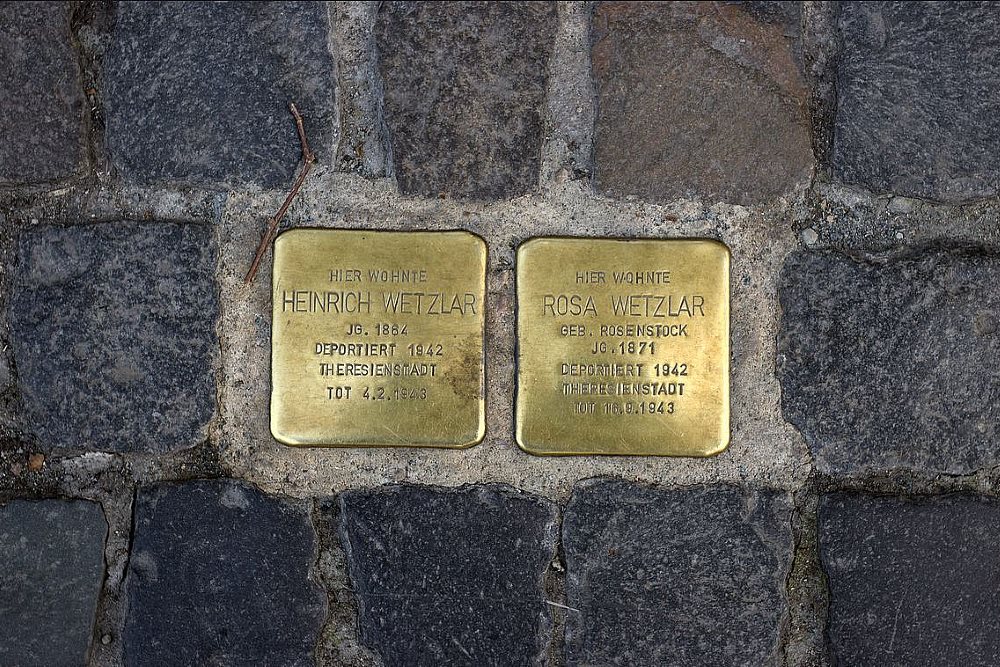Stumbling Stone Große Friedberger Straße 29
These small, brass, memorial plaques (stolpersteine or stumbling stones) commemorate:
* Heinrich Wetzlar, born 1864, deported 1942, Theresienstadt, dead 4 February 1943.
* Rosa Wetzlar née Rosenstock, born 1871, deported 1942, Theresienstadt, dead 16 September 1943.
Heinrich Wetzlar owned a footwear company called K. Drissler. He and Rosa Rosenstock married and had 2 children – Julius, born in 1895 in Bad Schwalbach, and Hedwig, born in 1906 in Frankfurt. From 1920 on, the family lived in the 2nd floor (European) of Grosse Friedberger Str. 29.
Son Julius Wetzlar married Else Wachenheimer, and they had a daughter, Lore. Daughter Hedwig Wetzlar married Leo Nussbaum; they had a son, Rolf. Both grandchildren (Lore and Rolf) were born in Germany in 1932. Some time after that, these two families fled to Montevideo, Uruguay.
Heinrich and Rosa Wetzlar stayed in Frankfurt. A 1939 letter from Heinrich about his household goods includes 3 musical instruments which he purchased before 1920 – a piano, a student violin, and a guitar. At some point, Heinrich and Rosa finalized a home purchasing contract [Heimeinkaufvertrag]; they hoped to use the contract to finance their move to a retirement home.
But they were not able to move. They were deported from Frankfurt on 1 September 1942 to Theresienstadt on a train with 1,109 other deportees. He was age 78, she was 71. Heinrich Wetzlar survived in Theresienstadt for 5 months, and Rosa Wetzlar another 7 months after him. Both are registered as "murdered" in the German Federal Archives.
"Stolpersteine" is an art project for Europe by Gunter Demnig to commemorate victims of National Socialism (Nazism). Stolpersteine (stumbling stones) are small, 10x10cm brass plaques placed in the pavement in front of the last voluntary residence of (mostly Jewish) victims who were murdered by the Nazis. Each plaque is engraved with the victim’s name, date of birth, and place (mostly a concentration camp) and date of death. By doing this, Gunter Demnig gives an individual memorial to each victim. One stone, one name, one person. He cites the Talmud: "A human being is forgotten only when his or her name is forgotten."
Do you have more information about this location? Inform us!
Source
Nearby
Point of interest
- Air-Raid Shelter Friedberger Anlage - Frankfurt am Main
- House Anne Frank - Frankfurt am Main
- Frank Family House - Frankfurt am Main
Monument
- Memorial Börneplatz Synagogue - Frankfurt am Main
- Jewish Memorial Frankfurt am Main - Frankfurt am Main
- Memorial Bombardments Frankfurt - Frankfurt am Main
Cemetery
- German War Graves Hauptfriedhof Frankfurt - Frankfurt am Main
- Mass Grave Concentration Camp Victims Frankfurt - Frankfurt am Main
- Soviet & Serbian War Graves Hauptfriedhof Frankfurt - Frankfurt am Main





